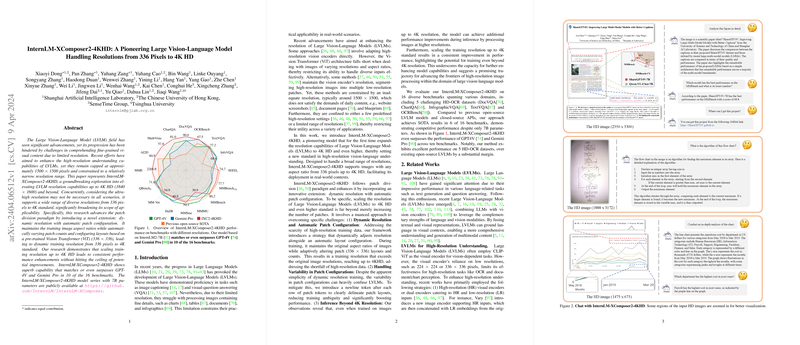Exploring the Capabilities of InternLM-XComposer2-4KHD in High-Resolution Vision-LLMing
Overview of InternLM-XComposer2-4KHD
InternLM-XComposer2-4KHD represents a significant step forward in the domain of Large Vision-LLMs (LVLMs), aiming to tackle one of the outstanding challenges in the field: the processing and understanding of high-resolution visual content. By extending the capabilities of LVLMs to handle resolutions up to 4K HD (3840 × 1600) and supporting a broad spectrum of resolutions starting from 336 pixels, this paper presents a novel approach to dynamic resolution and automatic patch configuration. This technique not only preserves the aspect ratio of images but also allows for automatic adjustment of patch counts and layouts, based on the resolution requirements dictated by the input image.
Key Contributions and Methodology
The paper outlines several notable contributions and methodological advancements:
- Dynamic Resolution and Automatic Patch Configuration: Introduced to handle a wide range of image resolutions effectively. This innovation allows the model to adjust its handling of image patches dynamically, according to the resolution of the input image, thus enabling it to effectively process high-resolution images up to 4K HD.
- Training and Performance Improvement with High Resolution: The paper demonstrates that scaling LVLM training to support high-resolution images leads to consistent performance improvements across multiple benchmarks, without reaching a performance saturation point. This suggests potential for future research into even higher resolution processing capabilities.
- Evaluation on Diverse Benchmarks: InternLM-XComposer2-4KHD is evaluated across 16 benchmarks, showing superior performance compared to existing models in 10 out of the 16 benchmarks and achieving state-of-the-art results in six of them. Particularly noteworthy is its performance on HD-OCR datasets where it significantly outperforms other models.
- Addressing Image 2D Structure Recognition: A novel approach utilizing a learnable newline token is introduced to improve the model's understanding of the 2D structure of images. This is particularly important for accurately processing documents, charts, tables, and infographics that rely on spatial arrangements and structures.
Implications and Future Directions
The research presents both practical and theoretical implications for the field of AI and machine learning:
- Practical Applicability in Real-World Scenarios: By significantly expanding the resolution capabilities, InternLM-XComposer2-4KHD supports a wider range of practical applications where fine-grained visual content understanding is crucial, including document analysis, content creation, and multimedia processing.
- Promising Direction for Future Research: The consistent performance improvement observed with increasing training resolutions indicates a promising direction for future research in LVLMs, particularly in exploring the upper limits of resolution enhancements and their impact on model performance.
- Reconsidering Patch Processing Techniques: The paper suggests that there is merit in revisiting and improving patch processing techniques for high-resolution image understanding. The dynamic resolution and automatic patch configuration approach proposed could inspire new methodologies in handling diverse input resolutions and aspect ratios efficiently.
Conclusion
InternLM-XComposer2-4KHD sets a new precedent in the LVLM domain by addressing the challenging aspect of high-resolution visual content processing. Through its novel approach to dynamic resolution handling and the significant performance improvements demonstrated across a variety of benchmarks, this model opens up new avenues for research and practical applications in the field of generative AI and vision-LLMing. Future studies building on this work may further expand the capabilities of LVLMs, potentially leading to even more sophisticated and versatile models capable of handling an even broader range of visual content with greater accuracy and efficiency.
